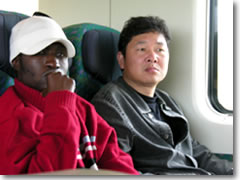Racial concerns for travelers
A traveler's guide to race matters in Europe and a frank rundown of what to expect if you're black, Asian, Arab, Indian, or otherwise not visibly of European descent

Though admittedly far from common yet, it's not unusual today to see people of all races and colors riding the trains in Europe.
The world is not yet color-blind, and Europe is no exception.
Anyone not visibly of European descent is often treated at least as a cultural oddity in Europe.
Rarely does it move beyond stares (though some African-American women do report a rather high incidence of impromptu marriage proposals in Italy).
When racism does rear its ugly head in Europe, thankfully it’s usually not in the form of physical violence.
Unfounded mistrust, however, can run rampant, and dark-skinned travelers often run into biased, infuriating treatment.
You may be questioned longer at border crossings and on trains and your bags may be rifled through by officials much more often than that of the white folks. At worst, a hotel may claim it’s full for the night and then give a room to the next white guy who walks through the door.
There’s little you can do about all this, although—in one of travel’s more unpleasant truisms—it helps to flash that American passport frequently and dress like a well-to-do tourist.
If you are wronged because of your skin tone, strike a blow for social consciousness by lodging a complaint with the local police or special “tourist police” branch.
Specific concerns for any group that doesn't look European
In general, African Americans and others with black skin won’t run into any more racism, and usually less, than they would at home (I know, that’s not saying much). Cities such as London and Paris have large local black populations, so you won’t stand out quite as much.
Be prepared to be treated sometimes with the double standards described previously and to be stared at, especially in smaller towns and in southern European countries. Europe has its share of skinheads, yes, but neo-Nazis are frankly more of a problem in the United States than they are in Germany.
People of North African, Middle Eastern, Arabic, or Baltic descent may run into more prejudice and hard feelings, as many from those cultures emmigrate to Europe. (The situation between many of these groups and the European majority parallels that between Mexican immigrants and the white majority in the United States.)
White Europeans are suspicious of people from the other side of the Mediterranean because many of them, fleeing poverty or political unrest, head to Europe (especially Italy, Germany, and France) for a “better life” of washing windows, selling trinkets, and similar work.
Unfortunately, high unemployment, the economic crisis, local public resentment, latent racism, and the rise of mafia-like immigrant employment syndicates all conspire to keep these people in their marginalized and denigrated role.
Do a bit of advance research to find out whether large immigrant groups have strained social tensions in certain areas (for example, Albanians in Italy, Algerians in France, Turks in Germany—which means anyone who looks Turkish, or even Greek).
Most of Europe doesn't seem to know what to make of folks from the Indian Subcontinent —except, of course, in London and other parts of the U.K. where there are huge Indian, Bangladeshi, Pakistani, and Sikh populations. You'll probably run into a bit of the "cultural oddity" reaction, a bit of the "scared of dark skin" reaction, and a bit of a "Huh, must be from London" reaction.
So many tour buses blow through Europe full of Japanese and other East Asian tourists on sightseeing tours/shopping sprees that folks whose heritage hails from the Far East should find a pretty friendly reception here. You won’t be the subject of nearly as many suspicions as other non-Europeans—though Europeans will often crack many lighthearted jokes involving your presumed penchant for taking photographs, or the traditional Japanese preference for baths over showers.
(And it doesn't really matter if you're Korean, Chinese, Thai, Malaysian, Filipino... the largest influx to Europe is from Japan, and since there are few East Asian communities in Europe, the locals are not yet very adept at telling the difference.)
Related articles |
Related Partners
|
This article was by Reid Bramblett and last updated in March 2012.
All information was accurate at the time.
Copyright © 1998–2013 by Reid Bramblett. Author: Reid Bramblett.

